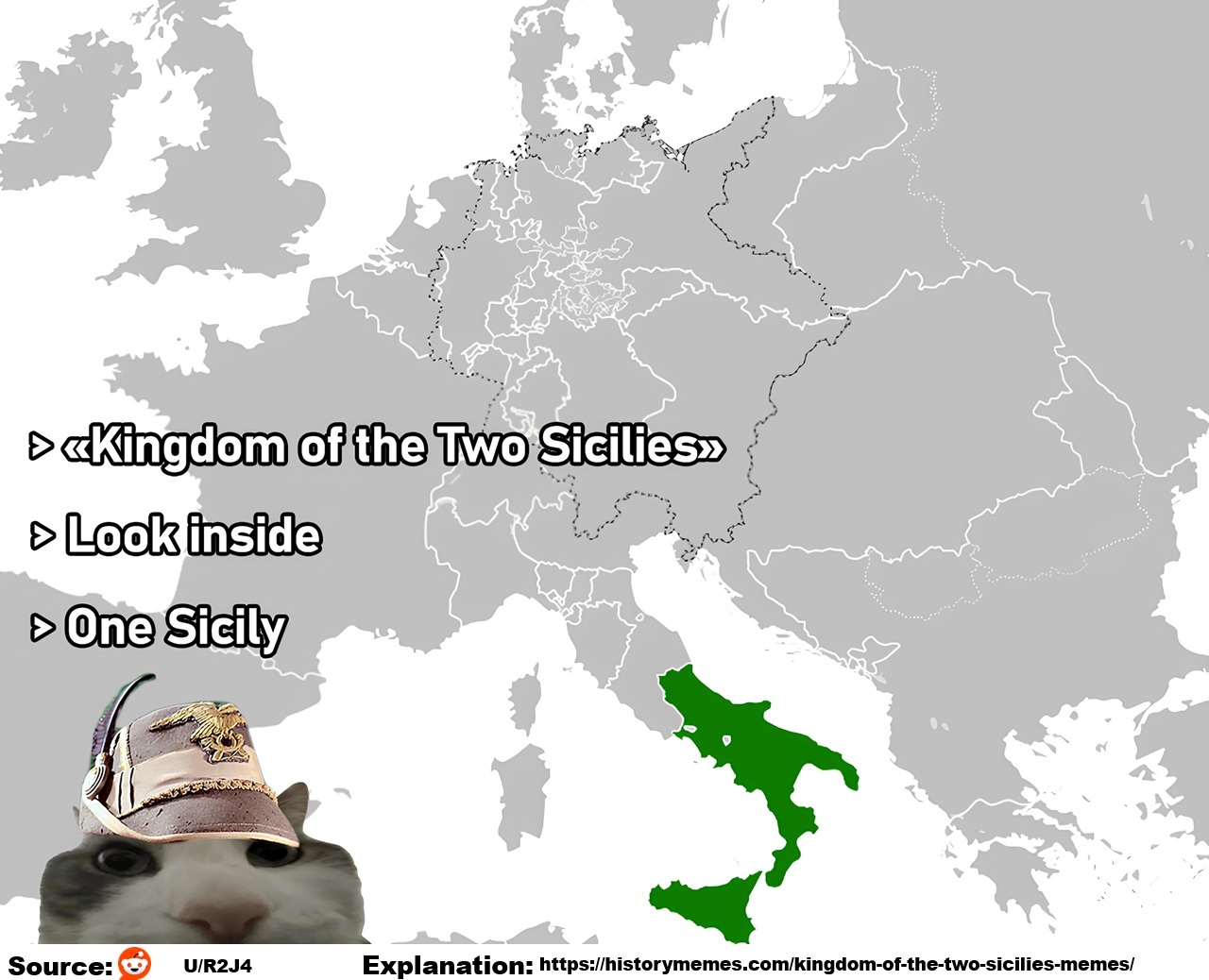
The meme above is a joke about the Kingdom of the Two Sicilies which existed in Southern Italy from 1816 to 1861.
So why was it called the Kingdom of the Two Sicilies when there is clearly only 1 Sicily?
The Kingdom of the Two Sicilies (Italian: Regno delle Due Sicilie) was not named because there were two physical islands called “Sicily.”
Rather, the name referred to two political entities that both historically bore the name “Sicily.”
Here’s how that came about:
The Norman Kingdom of Sicily (1130)
- When Roger II was crowned King of Sicily in 1130, his kingdom included the island of Sicily and the southern Italian mainland (the regions of Naples, Calabria, Apulia, etc.).
- So the “Kingdom of Sicily” originally meant both the island and much of southern Italy.
The split after the War of the Sicilian Vespers (1282)
- In 1282, a rebellion on the island of Sicily (against Angevin French rule) led to the island joining the Crown of Aragon.
- The Angevins (ruling from Naples) still claimed to be the legitimate Kings of Sicily, even though they only controlled the mainland.
- This created two “Sicilies”:
- The island of Sicily, under Aragonese control, often called the Kingdom of Sicily (Trinacria).
- The mainland kingdom, ruled from Naples, officially still styled the Kingdom of Sicily, but often called the Kingdom of Naples to avoid confusion.
Reunion under one crown (1816)
- After centuries of being ruled by the same monarch but as legally separate realms, King Ferdinand IV of Naples (also Ferdinand III of Sicily) merged them formally in 1816.
- He proclaimed a single state: the Kingdom of the Two Sicilies, acknowledging both the mainland “Sicily” and the island “Sicily” as the two constituent parts.
In short:
- There was only one island of Sicily, but two kingdoms historically called “Sicily.”
- “Two Sicilies” meant “the two Sicilian kingdoms”, one on the island, one on the mainland.
More about the Kingdom itself:
Origins
- Formed: 1816
- Capital: Naples (though Palermo was also an important royal city)
- Full name: Regno delle Due Sicilie (“Kingdom of the Two Sicilies”)
- Ruling dynasty: The Bourbons of Naples, a cadet branch of the Spanish Bourbons.
The kingdom united:
- The Kingdom of Naples (on the Italian mainland), and
- The Kingdom of Sicily (the island of Sicily).
For centuries, these two had been ruled by the same monarch but treated as distinct realms. In 1816, King Ferdinand IV of Naples (who was also Ferdinand III of Sicily) merged them into one unified kingdom after the Napoleonic Wars.
Geography and People
The Kingdom of the Two Sicilies was the largest and most populous of all the Italian states before unification:
- Population: around 8-9 million people in the mid-1800s (larger than Piedmont-Sardinia or the Papal States).
- It covered all of southern Italy, from Abruzzo and Naples down through Calabria, plus the entire island of Sicily.
- It was ethnically and linguistically diverse: Neapolitan, Sicilian, Calabrian, Greek, Albanian, and others all coexisted.
Economy and Society
- It was wealthy in natural resources, agriculture, and trade, especially early on.
- Naples was one of Europe’s largest cities, with impressive architecture, industry, and the first railway in Italy (opened 1839).
- However, the kingdom was also deeply conservative and centralized, censorship, limited political freedoms, and slow modernization made it appear “backward” compared to northern Italy by mid-century.
Bourbon Rule
The Bourbons (especially Ferdinand II, r. 1830–1859) maintained a strong, often repressive monarchy.
- The government was absolutist, not constitutional.
- Ferdinand II, nicknamed “Re Bomba” (“King Bomb”) for his heavy-handed suppression of revolts, cracked down on liberals and nationalists.
- The kingdom became isolated diplomatically and socially as liberalism and nationalism spread through Europe.
The Fall of the Kingdom
The Two Sicilies collapsed during the Italian Unification (Risorgimento):
- Garibaldi’s Expedition of the Thousand (1860)
- Giuseppe Garibaldi landed in western Sicily with about 1,000 volunteers, aiming to unite Italy under King Victor Emmanuel II of Sardinia-Piedmont.
- Despite being massively outnumbered, Garibaldi’s forces won rapid victories, helped by popular uprisings and discontent with Bourbon rule.
- Fall of Naples (1860)
- Garibaldi crossed the Strait of Messina, advanced through Calabria, and entered Naples to cheering crowds.
- King Francis II, the last Bourbon ruler, retreated to Gaeta but was ultimately defeated.
- Annexation to Italy (1861)
- The Kingdom of the Two Sicilies was officially annexed by the Kingdom of Italy, proclaimed in March 1861.
- Francis II went into exile, marking the end of Bourbon rule in Italy.
Legacy
- The Two Sicilies left behind a mixed legacy:
- Culturally rich, with strong traditions in art, architecture, and music (Naples was a leading opera center).
- But also remembered for economic inequality and authoritarian rule.
- Its fall marked the beginning of the “Southern Question, ”the economic and social divide between northern and southern Italy, which persists in some form even today.
More memes:

And

Leave a Reply